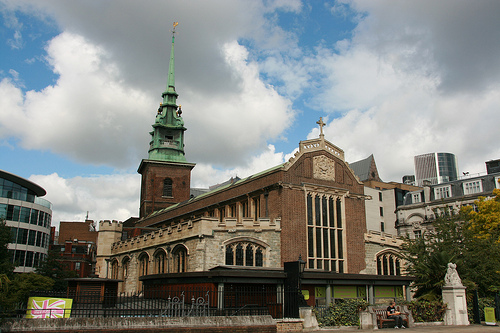London’s Old Hallows – England’s Oldest Church
It was the Saxon Abbey at Barking that established the Church of All Hallows by the Tower in 675AD, making it officially the oldest church anywhere in England. At the time of its construction it was built upon the site of an even earlier Roman structure, this is known as traces of this earlier building were discovered in the crypt of the church. It was known as All Hallows by the Tower due to its proximity close to the infamous Tower of London, and as such grew connections with many royal figures. It was designated a Royal Chantry at the request of King Edward IV and became a temporary resting place for the residents of the tower that met their death on the axe man’s block. This is where they were interred for a while before being moved on to their final resting place.
History
The church hasn’t always had a quiet and peaceful existence. In 1650 it was badly damaged by an explosion – barrels of gunpowder that were being stored within the grounds of the church accidentally went off causing much devastation. The blast not only destroyed the church tower but almost fifty nearby houses were destroyed too with many fatalities. Thankfully by 1658 the tower had been rebuilt, but it was not long before it was at risk of destruction from another source.
If it wasn’t for the quick thinking of Admiral William Penn, who ordered men from the naval yard nearby to start demolishing the buildings that surrounded the church in order to make a fire break, the church would have succumbed to the ravages of the Great Fire of London. In fact during the great fire in 1666 Samuel Pepys himself is said to have climbed to the top of the tower to witness the devastation caused by the fire for himself, and watch the fires progress across the city.
Going even further back in time, legend claims that the heart of King Richard I is located somewhere in the northern section of the church building, buried beneath what was the King’s 12th century chapel which once stood on the site. If you want a church to have atmosphere this one has centuries of it!
The Church Today
Extensive restorations took place during the 19th century, but once again the church was severely damaged, this time by German bombs during the Blitz, the final round of restoration work finally being completed in 1957. Thankfully the oldest part of the church has seen some sympathetic restoration, and one of the original Saxon doorways dating from the 7th century still survives. Inside too are many original brasses, and quite handily there is a brass rubbing centre located here too.
Wherever you look you will find evidence of the long history of the building, from the 15th and 16th century statues to the wonderfully carved font which was carved back in 1682. The churchyard too has been subject to archaeological digs and much has been discovered which shines a light on the past of this incredible building which has withstood more than any other building in London.


